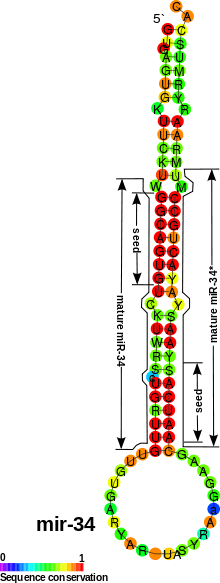mir-34 microRNA precursor family
| mir-34 microRNA precursor family | |
|---|---|
 | |
| Predicted secondary structure and sequence conservation of mir-34 | |
| Identifiers | |
| Symbol | mir-34 |
| Rfam | RF00456 |
| miRBase | MI0000268 |
| miRBase family | MIPF0000039 |
| Other data | |
| RNA type | Gene; miRNA |
| Domain(s) | Eukaryota |
| GO | 0035195 0035068 |
| SO | 0001244 |
The mir-34 microRNA precursor family are non-coding RNA molecules that, in mammals, give rise to three major mature miRNAs. The miR-34 family members were discovered computationally[1] and later verified experimentally.[2][3] The precursor miRNA stem-loop is processed in the cytoplasm of the cell, with the predominant miR-34 mature sequence excised from the 5' arm of the hairpin. The mature miR-34a is a part of the p53 tumor suppressor network; therefore, it is hypothesized that miR-34 dysregulation is involved in the development of some cancers.[4][5]
The miR-34 family
In mammals, three miR-34 precursors are produced from two transcriptional units.[6] The human miR-34a precursor is transcribed from chromosome 1. The miR-34b and miR-34c precursors are co-transcribed from a region on chromosome 11, apparently as part of a transcript known as BC021736.
Expression of MIR34A_(gene) in mouse is observed in all tissues examined but is highest in brain. miR-34b and -c are relatively less abundant in most tissues, but are the predominant miR-34 species in lung.[6] The presence of miR-34 products has also been confirmed in embryonic stem cells. miR-34 has been shown to be maternally inherited in Drosophila and zebrafish and the loss of miR-34 resulted in defects in hindbrain development in zebrafish embryos. This was the first report of knockdown phenotype of miR-34 in any model organism although the phenotype was observed in only about 30% of zebrafish embryos.[7]
Targets of miR-34
Yamakuchi et al.. showed that miR-34a targets the silent information regulator 1 (SIRT1) gene:[8]
- "miR-34 inhibition of SIRT1 leads to an increase in acetylated p53 and expression of p21 and PUMA, transcriptional targets of p53 that regulate the cell cycle and apoptosis, respectively. Furthermore, miR-34 suppression of SIRT1 ultimately leads to apoptosis in WT human colon cancer cells but not in human colon cancer cells lacking p53. Finally, miR-34a itself is a transcriptional target of p53, suggesting a positive feedback loop between p53 and miR-34a. Thus, miR-34a functions as a tumor suppressor, in part, through a SIRT1-p53 pathway."[8]
Recently Quantitative proteomics - SILAC approach was used to identify miR-34a targets at genome level in HEK293T cells.[9]
Mir-34 inhibits human p53-mutant gastric cancer tumorspheres
p53-deficient human gastric cancer cells, restoration of functional miR-34 inhibits cell growth and induces chemosensitization and apoptosis, indicating that miR-34 may restore p53 function. Restoration of miR-34 inhibits tumorsphere formation and growth, which is reported to be correlated to the self-renewal of cancer stem cells. The mechanism of miR-34-mediated suppression of self-renewal appears to be related to the direct modulation of downstream targets Bcl-2, Notch, and HMGA2, indicating that miR-34 may be involved in gastric cancer stem cell self-renewal/differentiation decision-making.[10][11] miR-34c has also been associated to bone development and bone cancer.[12]
References
- ↑ Lim, LP; Glasner ME; Yekta S; Burge CB; Bartel DP (2003). "Vertebrate microRNA genes". Science 299 (5612): 1540–. doi:10.1126/science.1080372. PMID 12624257.
- ↑ Dostie, J; Mourelatos Z; Yang M; Sharma A; Dreyfuss G (2003). "Numerous microRNPs in neuronal cells containing novel microRNAs". RNA 9 (2): 180–186. doi:10.1261/rna.2141503. PMC 1370383. PMID 12554860.
- ↑ Houbaviy HB, Murray MF, Sharp PA (2003). "Embryonic stem cell-specific MicroRNAs.". Dev Cell 5 (2): 351–8. doi:10.1016/S1534-5807(03)00227-2. PMID 12919684.
- ↑ Mraz, M.; Malinova, K.; Kotaskova, J.; Pavlova, S.; Tichy, B.; Malcikova, J.; Stano Kozubik, K.; Smardova, J.; Brychtova, Y.; Doubek, M.; Trbusek, M.; Mayer, J.; Pospisilova, S. (2009). "MiR-34a, miR-29c and miR-17-5p are downregulated in CLL patients with TP53 abnormalities". Leukemia 23 (6): 1159–1163. doi:10.1038/leu.2008.377. PMID 19158830.
- ↑ He L, He X, Lim LP et al. (June 2007). "A microRNA component of the p53 tumour suppressor network". Nature 447 (7148): 1130–4. doi:10.1038/nature05939. PMID 17554337.
- ↑ 6.0 6.1 Hermeking, H. (2009). "The miR-34 family in cancer and apoptosis". Cell Death and Differentiation 17 (2): 193–199. doi:10.1038/cdd.2009.56. PMID 19461653.
- ↑ Soni, Kartik; Ashwani Choudhary, Ashok Patowary, Angom Ramcharan Singh, Shipra Bhatia, Sridhar Sivasubbu, Shanti Chandrasekaran and Beena Pillai (March 2013). "miR-34 is maternally inherited in Drosophila melanogaster and Danio rerio". Nucleic Acids Research 41 (8): 4470–4480. doi:10.1093/nar/gkt139.
- ↑ 8.0 8.1 Yamakuchi M, Ferlito M, Lowenstein CJ (September 2008). "miR-34a repression of SIRT1 regulates apoptosis". Proceedings of the National Academy of Sciences of the United States of America 105 (36): 13421–6. doi:10.1073/pnas.0801613105. PMC 2533205. PMID 18755897.
- ↑ Bargaje R, Gupta S, Sarkeshik A, Park R, Xu T et al. (2012). "Identification of Novel Targets for miR-29a Using miRNA Proteomics". PLoS ONE 7 (8): e43243. doi:10.1371/journal.pone.0043243.
- ↑ Ji Q, Hao X, Meng Y, Zhang M, Desano J and Fan D et al. Restoration of tumor suppressor miR-34 inhibits human p53-mutant gastric cancer tumorspheres. BMC Cancer 2008; 8: 266.
- ↑ Mir-34 and p53 pathway
- ↑ Bae, Y.; Yang, T.; Zeng, H.-C.; Campeau, P. M.; Chen, Y.; Bertin, T.; Dawson, B. C.; Munivez, E.; Tao, J.; Lee, B. H. (12 April 2012). "miRNA-34c regulates Notch signaling during bone development". Human Molecular Genetics. doi:10.1093/hmg/dds129.
External links
- Page for mir-34 microRNA precursor family at Rfam
- miRBase entry for mouse miR-34a (mmu-miR-34a)
- miRBase entry for human miR-34a (hsa-miR-34a)
| ||||||||||||||||||